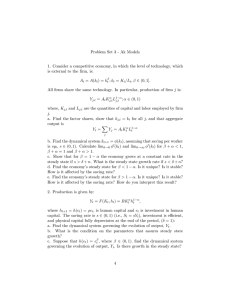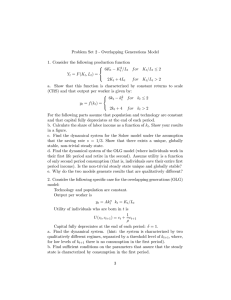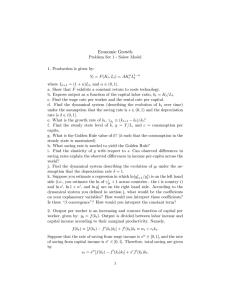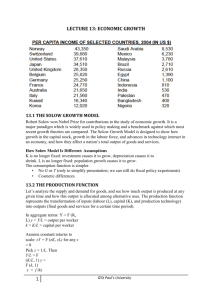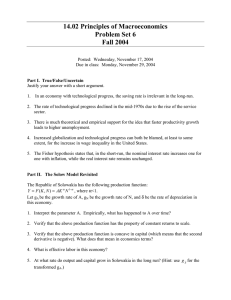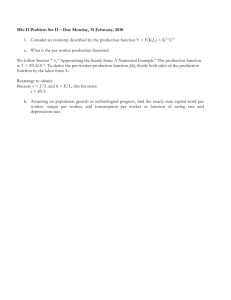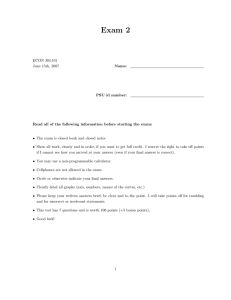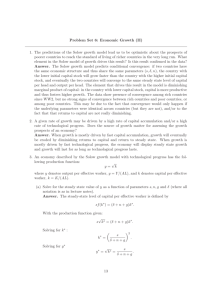Economic Growth
advertisement
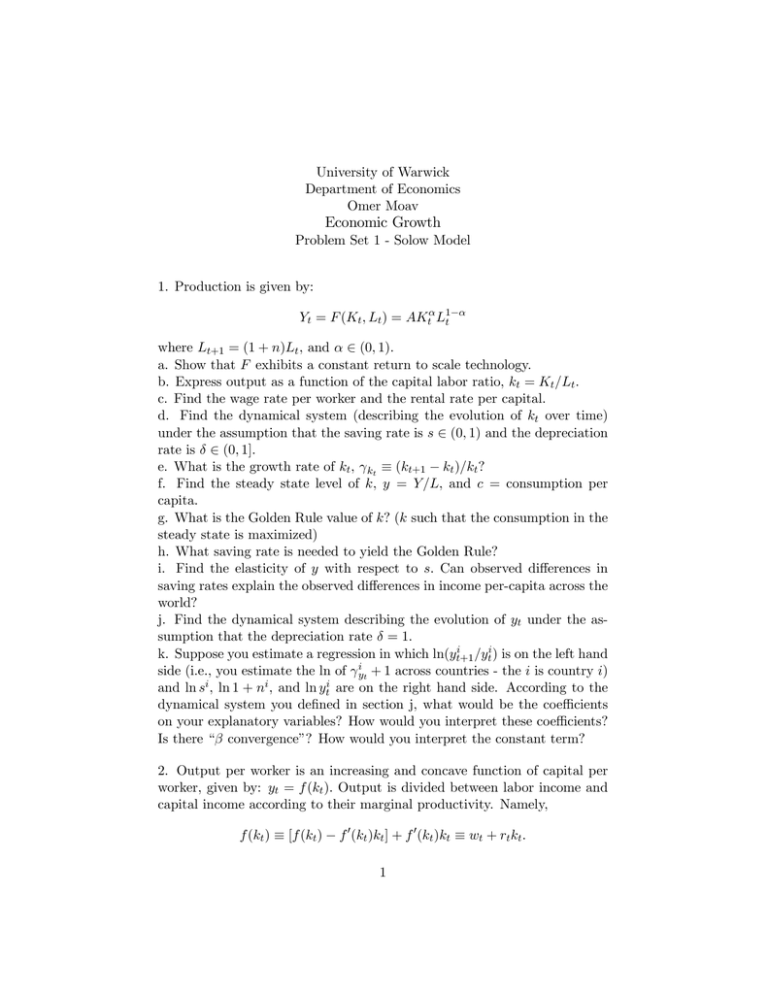
University of Warwick Department of Economics Omer Moav Economic Growth Problem Set 1 - Solow Model 1. Production is given by: = ( ) = 1− where +1 = (1 + ) and ∈ (0 1) a. Show that exhibits a constant return to scale technology. b. Express output as a function of the capital labor ratio, = . c. Find the wage rate per worker and the rental rate per capital. d. Find the dynamical system (describing the evolution of over time) under the assumption that the saving rate is ∈ (0 1) and the depreciation rate is ∈ (0 1] e. What is the growth rate of ≡ (+1 − ) ? f. Find the steady state level of = and = consumption per capita. g. What is the Golden Rule value of ? ( such that the consumption in the steady state is maximized) h. What saving rate is needed to yield the Golden Rule? i. Find the elasticity of with respect to Can observed differences in saving rates explain the observed differences in income per-capita across the world? j. Find the dynamical system describing the evolution of under the assumption that the depreciation rate = 1 ) is on the left hand k. Suppose you estimate a regression in which ln(+1 side (i.e., you estimate the ln of + 1 across countries - the is country ) and ln , ln 1 + , and ln are on the right hand side. According to the dynamical system you defined in section j, what would be the coefficients on your explanatory variables? How would you interpret these coefficients? Is there “ convergence”? How would you interpret the constant term? 2. Output per worker is an increasing and concave function of capital per worker, given by: = ( ) Output is divided between labor income and capital income according to their marginal productivity. Namely, ( ) ≡ [ ( ) − 0 ( ) ] + 0 ( ) ≡ + 1 Suppose that the rate of saving from wage income is ∈ [0 1] and the rate of saving from capital income is ∈ [0 1] Therefore, total saving are given by = [ ( ) − 0 ( ) ] + 0 ( ) Population and technology are constant and the rate of capital depreciation, ∈ (0 1) a. Derive the dynamical system governing the evolution of capital per capita: +1 = ( ). b. Suppose there exist a range of where 000 () = 0 (the third derivative is zero). Find a condition on the saving rates and such that the dynamical system, +1 = ( ) is convex (00 ( ) 0) in the range of 000 () = 0? Suppose now that = 0 and ( ) = ln(1 + ): c. Derive the dynamical system +1 = ( ) d. Find 0 ( ) lim →0 0 ( ) lim →∞ 0 ( ) and 00 ( ) e. Is the trivial steady state, = 0 locally stable? Explain. f. Find the range of in which the dynamical system is strictly convex. g. Show that for = 0 a non-trivial steady state level of does not exist (that is, explain why there exists no ̄ 0 such that ̄ = (̄)). Find the growth rate of (i.e., +1 − 1) as → ∞ for = 0 3. Production is given by: = ( ) = ( )1− where +1 = (1 + ) , +1 = (1 + ) and ∈ (0 1) a. Find the dynamical system describing the evolution of = Find the steady state level of What is the growth rate of output per worker, = , in the steady state? What is the growth rate of capital per worker, = in the steady state? b. According to Solow’s growth accounting, the growth in Total Factor Productivity (TFP) is calculated by ∆ ∆̃ ∆ = − ̃ ̃ where ≡ ̃ ≡ , ̃ is the elasticity of with respect to (which is equal to the share of capital in a competitive economy), and ∆ is the change in the variable = Find TFP growth rate, ∆ in the steady state according to the model in part a? 2
